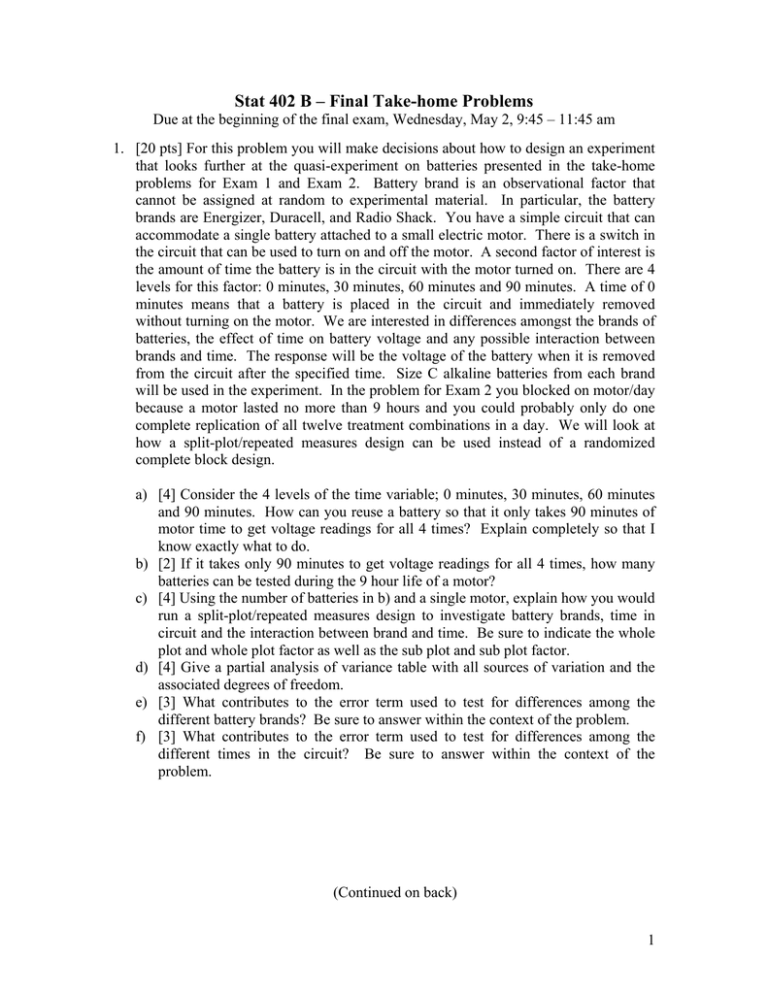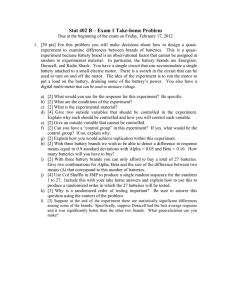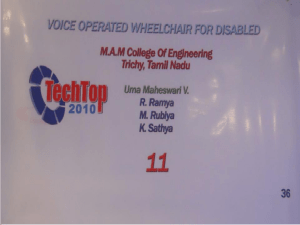Stat 402 B – Final Take-home Problems
advertisement

Stat 402 B – Final Take-home Problems Due at the beginning of the final exam, Wednesday, May 2, 9:45 – 11:45 am 1. [20 pts] For this problem you will make decisions about how to design an experiment that looks further at the quasi-experiment on batteries presented in the take-home problems for Exam 1 and Exam 2. Battery brand is an observational factor that cannot be assigned at random to experimental material. In particular, the battery brands are Energizer, Duracell, and Radio Shack. You have a simple circuit that can accommodate a single battery attached to a small electric motor. There is a switch in the circuit that can be used to turn on and off the motor. A second factor of interest is the amount of time the battery is in the circuit with the motor turned on. There are 4 levels for this factor: 0 minutes, 30 minutes, 60 minutes and 90 minutes. A time of 0 minutes means that a battery is placed in the circuit and immediately removed without turning on the motor. We are interested in differences amongst the brands of batteries, the effect of time on battery voltage and any possible interaction between brands and time. The response will be the voltage of the battery when it is removed from the circuit after the specified time. Size C alkaline batteries from each brand will be used in the experiment. In the problem for Exam 2 you blocked on motor/day because a motor lasted no more than 9 hours and you could probably only do one complete replication of all twelve treatment combinations in a day. We will look at how a split-plot/repeated measures design can be used instead of a randomized complete block design. a) [4] Consider the 4 levels of the time variable; 0 minutes, 30 minutes, 60 minutes and 90 minutes. How can you reuse a battery so that it only takes 90 minutes of motor time to get voltage readings for all 4 times? Explain completely so that I know exactly what to do. b) [2] If it takes only 90 minutes to get voltage readings for all 4 times, how many batteries can be tested during the 9 hour life of a motor? c) [4] Using the number of batteries in b) and a single motor, explain how you would run a split-plot/repeated measures design to investigate battery brands, time in circuit and the interaction between brand and time. Be sure to indicate the whole plot and whole plot factor as well as the sub plot and sub plot factor. d) [4] Give a partial analysis of variance table with all sources of variation and the associated degrees of freedom. e) [3] What contributes to the error term used to test for differences among the different battery brands? Be sure to answer within the context of the problem. f) [3] What contributes to the error term used to test for differences among the different times in the circuit? Be sure to answer within the context of the problem. (Continued on back) 1 2. [20 pts] An experiment is performed on a new piece of drilling equipment. The response variable is the rate of advance of the drill. The four factors (each with a low (–1) and high (+1) level) are A: Load on the drill, B: Flow Rate through the drill, C: Speed of Rotation, D: Amount of Mud used in drilling. The experiment is run as a single replicate full factorial with five center points. The data are given below. Refer to the JMP output for drilling experiment. Trmt. Comb. 1 a b ab c ac bc abc d ad bd abd cd acd bcd abcd Center Center Center Center Center A –1 +1 –1 +1 –1 +1 –1 +1 –1 +1 –1 +1 –1 +1 –1 +1 0 0 0 0 0 B –1 –1 +1 +1 –1 –1 +1 +1 –1 –1 +1 +1 –1 –1 +1 +1 0 0 0 0 0 C –1 –1 –1 –1 +1 +1 +1 +1 –1 –1 –1 –1 +1 +1 +1 +1 0 0 0 0 0 D –1 –1 –1 –1 –1 –1 –1 –1 +1 +1 +1 +1 +1 +1 +1 +1 0 0 0 0 0 Rate 1.68 1.98 3.28 3.44 4.98 5.70 9.93 9.07 2.07 2.44 4.09 4.53 7.77 8.43 11.75 12.30 4.54 5.18 5.53 4.49 5.01 a) [6] Give the overall sample mean and the estimated effects for the factorial portion of the experiment. b) [3] Give the mean at the center points and the sample variance at the center points. c) [6] Use the sample variance at the center points as your Mean Square Error to determine which factors or interactions are statistically significant. Support your determinations with appropriate test statistics and P-values. d) [5] Is the mean for the center points statistically different from overall mean for the 16 factorial treatment combinations? Support your answer with an appropriate test statistic and P-value. 2




